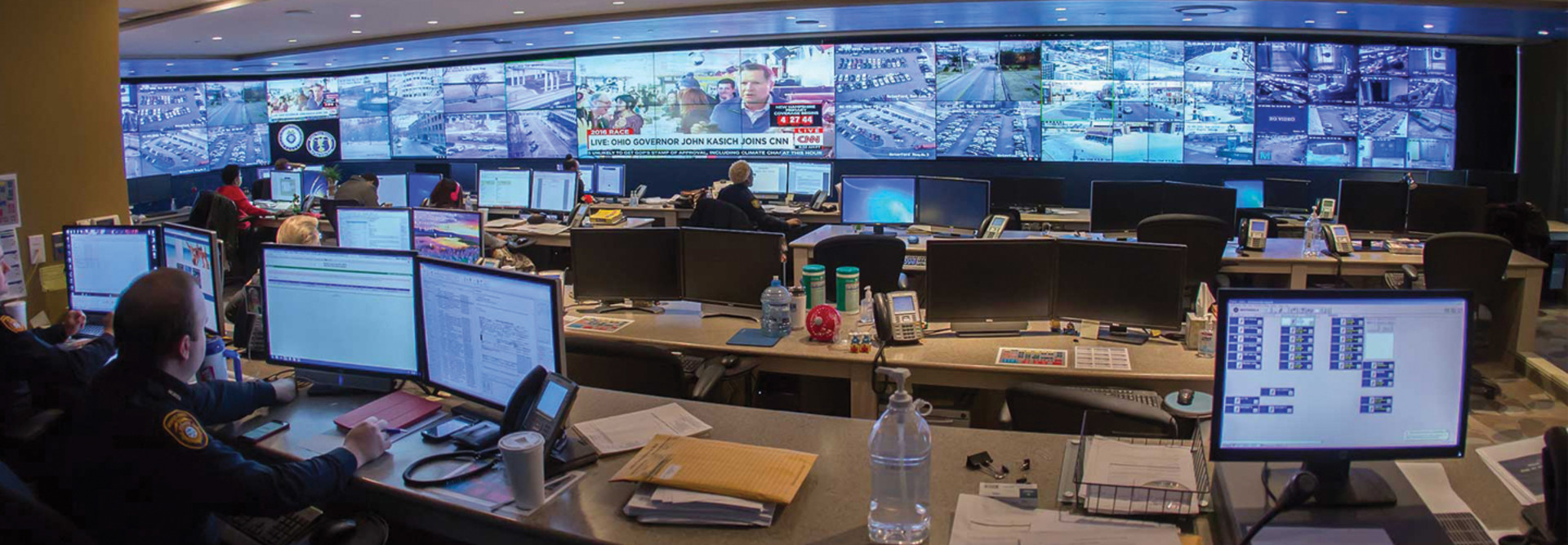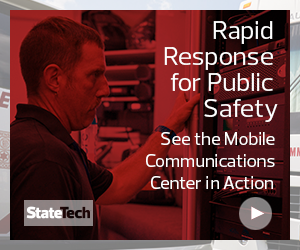What Is Video Wall Technology and How Do Agencies Use It?
Video walls are a fairly self-explanatory technology. They are usually placed in large command centers along one or more walls and cover the entire wall with digital screens, which are placed next to each other to form a single, massive display area. The individual displays can show unique feeds and information or be combined to show a feed on a larger display area.
Video wall systems are not just used for displaying feeds from surveillance cameras. They can display computer-aided dispatch (CAD) data for police departments, show interactive maps and display other software applications.
The Memphis Police Department’s video wall was born out of a prior directive to shift to data-driven policing, Chandler says, and the Real Time Crime Center was born in 2008. The video wall was added as the RTCC grew, and was originally a bank of flat-screen, 50-inch TVs.
The department decided it needed to upgrade and looked to other police departments and real-time crime centers for inspiration, eventually settling on Planar as its vendor. The wall is used for displaying CAD dispatch information or for monitoring large events in the city, according to Chandler. That way, the department is able to “coordinate and become an operations center for those events,” he says. The wall can even display video from police cars.
The department also as an interactive Google Map that is connected to gunshot detection technology deployed in the city. If a gunshot is detected, the map jumps to that location and the department can review video footage from the area to determine if a gunshot actually occurred.
Nearly 600 miles north, the Chicago Police Department uses a video wall from Planar for similar reasons. The department has an 18-component video wall in its Crime Prevention and Information Center, and it provides 24/7 monitoring capabilities for the department, says Jonathan Lewin, chief of CPD’s Bureau of Technical Services.
The video wall could be used to monitor multiple emerging events or provide proactive viewing of cameras in areas that have a need for special attention, Lewin says, such as a large event like the city’s recent Chicago Pride Parade or the Taste of Chicago food festival. In addition to CAD information, gunshot detection and video surveillance, the video wall displays open source social feeds on events and provides real-time mapping.
The CPIC serves as fusion center for the department, and the video wall gives officers and commanders a “better ability to more proactively monitor and manage both preplanned and unplanned situations and events” in the city, Lewin says. It provides “more proactive situational awareness to inform resource deployment decisions” and to provide intelligence to officers and first responders in the field so that they can be both safe and effective, according to Lewin.
MORE FROM STATETECH: Discover the operational benefits of public safety tech innovations.
Traffic Management Video Wall Tech Solutions
Video wall systems are not just used for crime prevention and response. They also enable more efficient traffic management.
“Leveraging our user-friendly control software, operators can instantly push content to the displays, zoom in to evaluate incidents, and work collaboratively to coordinate response efforts,” video wall vendor CineMassive notes on its website. “Content can also be shared across the network, enabling secure collaboration with remote stakeholders.”
In Boston, the city has deployed traffic signals timed from a central computer at 593 locations. There is also a series of 550 cameras deployed at intersections that report back to the city’s Traffic Management Center to monitor traffic flow. The TMC uses a large video wall to keep track of all of those camera feeds.
Gina Fiandaca, the former commissioner of the Boston Transportation Department, previously told StateTech that during the winter of 2015, when Boston was hit with 9 feet of snow inside of three weeks, the TMC would deliver up-to-date information on the status of snow removal and traffic.
The Washington State Department of Transportation also uses a video wall in its Traffic Management Center. In 2015, the agency wanted to upgrade its monitoring capabilities in a new building to gain more situational awareness and agility to respond to changing traffic conditions.
“With approximately 750 cameras to keep an eye on, a video wall was a crucial part of the building’s design,” Digital Signage Connection reports. “Incorporating a large number of monitors would allow the team to pull up a plethora of highway accidents, traffic jams, tunnels and more that need to be viewed simultaneously and at a moment’s notice.”
The agency ultimately went with NEC for its video wall solution because it wanted to “use individual monitors to allow for the purchase of new hardware as needed, rather than using a monolithic wall,” according to Digital Signage Connection. NEC gave the agency a clear cost estimate, and its displays also have an ultrathin bezel, which “was crucial to allow for looking at single images across multiple monitors,” the publication reports.
What Are the Best Video Wall Systems and Software?
There are multiple video wall display and software providers for public safety agencies to choose from, including CineMassive, Planar, NEC and Barco.
Each promotes its solutions as a panacea for agencies. “A CineMassive visualization system unites all of your team’s critical data on a multi-HD video wall, delivering a complete, real-time operating picture,” CineMassive notes on its website.
In practical terms, agencies need to think through their needs when deciding which display and software technology to invest in for a video wall.
The Chicago Police Department’s Lewin said the city’s CPIC was first built in 2006 and had a video wall back then. At the time, there was a need for a large format display to produce a wide range of situational awareness indictors, he says.
In 2017, CPD decided to upgrade to the system from Planar because it needed a high-definition display. “It was an upgrade to the technology and enhancement to the resolution to support the city’s new HD cameras,” he says. The CPIC has access to 33,500 cameras owned by police and emergency services, and then more than 300,000 cameras from the private sector, Chicago Transit Authority, Chicago Park District and Chicago Public Schools.











